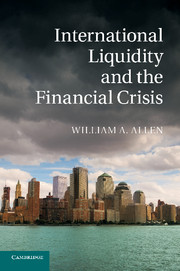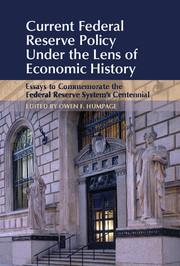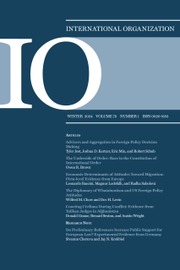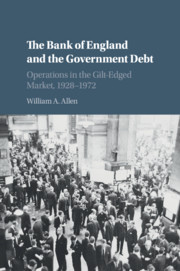International Liquidity and the Financial Crisis
- Author: William A. Allen
- Date Published: April 2014
- availability: Available
- format: Paperback
- isbn: 9781107420328
Paperback
Other available formats:
Hardback, eBook
Looking for an inspection copy?
This title is not currently available for inspection. However, if you are interested in the title for your course we can consider offering an inspection copy. To register your interest please contact [email protected] providing details of the course you are teaching.
-
In the ongoing financial crisis, policy makers have for the most part appeared to be reactive, formulating emergency solutions as events unfold. However, in contrast to their performance during the Great Depression, central banks around the world, led by the Federal Reserve, acted decisively following the collapse of Lehman Brothers and provided huge injections of liquidity into the financial markets, thereby preventing a far worse outcome. International Liquidity and the Financial Crisis compares the 2008 crisis with the disaster of 1931 and explores the similarities and differences. It considers the lasting effects of the crisis on international liquidity, the possibilities for an international lender of last resort, and the enlargement of the International Monetary Fund after the crisis. It shows that there is no clear demarcation between monetary and macro-prudential policies, and discusses how central banks need to adapt to a new environment in which global liquidity is much scarcer.
Read more- Presents a comprehensive view of the effects of the financial crisis on international liquidity
- Based on a forensic examination of facts rather than theory
- Discusses both the historical perspective and the future legacy of the crisis
Reviews & endorsements
'The financial crisis that began in 2007 is a terrifying event, comparable only with the Great Depression between the world wars. Few expected it. Its effects spread almost everywhere. But it could have been so much worse. Allen's powerful new book moves from where, how and why it began, to describe and analyse the numerous things that central banks and governments around the world did to try to contain it. This volume is a well documented, highly readable must-read for everyone interested in the largely untold story of how it was that official reactions would help to prevent a really nasty crisis turning into an absolute disaster.' Peter Sinclair, University of Birmingham
See more reviews'Shortage of liquidity can destroy a bank within hours; shortage of capital leads to a slow death. Yet in recent years regulators and academics have concentrated their attention on bank capital and almost ignored liquidity. In this book, Bill Allen returns to the tradition of the great writers on banking, Thornton and Bagehot, and analyzes what liquidity is, how it matters, and how neglect of it contributed to the recent crisis. This is a good and important book which manages to be both timely and of enduring worth.' Geoffrey Wood, Emeritus Professor, University of Buckingham and Emeritus Professor, Cass Business School, City University, London
'Bill Allen has written an outstanding, lucid account of the financial crisis and international liquidity flows. He shows how central banks responded to the crisis and makes a telling comparison with the last big international financial crisis in the 1930s.' Forrest Capie, Emeritus Professor, Cass Business School, City University, London
'Bill Allen has written a very clear account of the interaction between the withdrawal of liquidity from wholesale financial markets in 2007/8/9 and the unfolding of the crisis. He attributes the relative success, compared to 1931, of the steps taken to counteract the 2008/9 crisis to the willingness of Central Banks to expand their balance sheets, with particular emphasis on the Fed's willingness to extend dollar swaps to other countries. Ben Bernanke will find this a pleasure to read; so will you, and so did I, perhaps particularly, the nice short chapter (5) on changes, under pressure, to Central Bank theories and practice.' Charles Goodhart, Emeritus Professor, London School of Economics and Political Science
'This excellent book should be required reading for all central-bank governors [and] will remain a valuable resource for economists and financial historians for many years to come.' Nicholas Crafts, The Business Economist
Customer reviews
Not yet reviewed
Be the first to review
Review was not posted due to profanity
×Product details
- Date Published: April 2014
- format: Paperback
- isbn: 9781107420328
- length: 270 pages
- dimensions: 229 x 152 x 14 mm
- weight: 0.37kg
- contains: 36 b/w illus. 49 tables
- availability: Available
Table of Contents
1. Introduction
2. The domestic liquidity crisis in the USA
3. International liquidity crises outside the USA
4. Effects on financial markets outside the USA
5. The theory of central banking before the crisis and the practice of central banking during the crisis
6. Swap lines
7. Which countries received swap lines?
8. Did the swap providers achieve their objectives?
9. How did the swap lines affect the recipients?
10. Propagation and scale of the 1931 crisis
11. The management of the 1931 crisis
12. A comparison of 1931 and 2008
13. International liquidity management.
Sorry, this resource is locked
Please register or sign in to request access. If you are having problems accessing these resources please email [email protected]
Register Sign in» Proceed
You are now leaving the Cambridge University Press website. Your eBook purchase and download will be completed by our partner www.ebooks.com. Please see the permission section of the www.ebooks.com catalogue page for details of the print & copy limits on our eBooks.
Continue ×Are you sure you want to delete your account?
This cannot be undone.
Thank you for your feedback which will help us improve our service.
If you requested a response, we will make sure to get back to you shortly.
×









